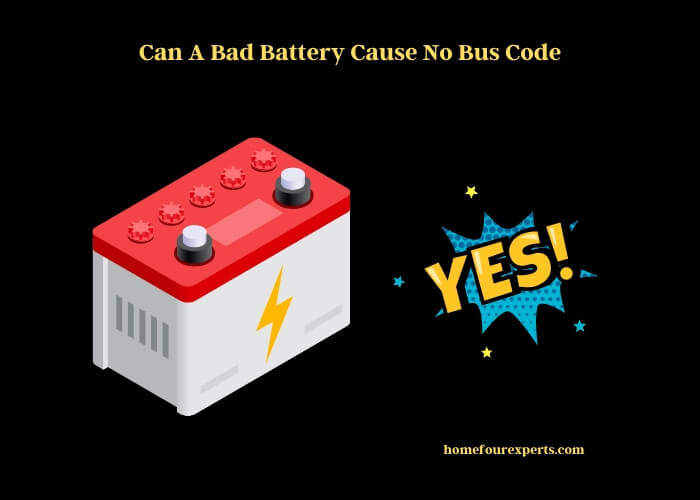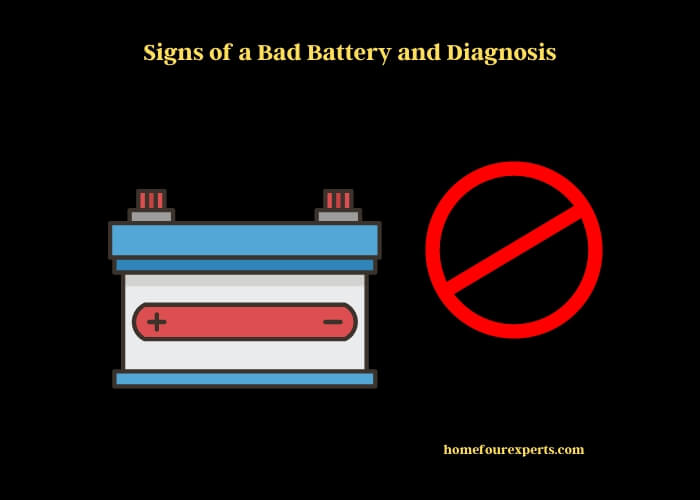Yes, a bad battery can indeed lead to a no bus code. Battery voltage is critical in ensuring smooth communication within the vehicle’s electrical system.
In the realm of vehicle diagnostics, the battery plays a key role. It powers the electrical system, including the Powertrain Control Module (PCM) that controls a network of sensors and actuators in the engine and transmission. This complex system relies heavily on the right battery voltage. If the battery is in bad condition, it can disrupt this interplay leading to grounding issues and no bus codes.

Corroded terminals often accompany a bad battery. Corrosion can interrupt the flow of electrical power to the vehicle’s electrical system, causing communication issues. For example, CAN Bus Communication, a method that allows various components of the vehicle to communicate with each other, can be disrupted, leading to fault codes or a no bus code.
The on-board diagnostics system uses these fault codes to notify the driver or the mechanic of problems with the vehicle. If the battery is bad, it may not be providing enough power for the PCM to communicate with these sensors properly. Faulty sensors or those not receiving adequate power can further aggravate the situation, resulting in the appearance of a no bus code. So, it becomes necessary to examine the health of the battery as a potential source of these codes, ensuring that it is neither low on voltage nor causing electrical interruptions.
The Core Concept: No Bus Code
Definition and Function of a No Bus Code
A “No Bus Code” is an error message displayed on a vehicle’s instrument cluster. It signifies a disruption or complete breakdown in the communication line—also known as the bus—between the various control modules within the vehicle. This can severely affect the performance and safety of the vehicle.
Typical Symptoms and Causes of a No Bus Code
Symptoms of a No Bus Code may include the vehicle stalling, failing to start, or performing poorly. The causes can be varied, ranging from faulty wiring to defective modules or sensor failures. However, a common and often overlooked cause is an unhealthy car battery.
Vehicle Electrical Architecture
Role of the Battery in a Vehicle’s Electrical System
The battery is the heart of a vehicle’s electrical system. It provides the electrical charge needed to start the engine and powers all the electrical and electronic components in the vehicle—from the headlights to the control modules.
Interaction of the Power Control Module (PCM) with Other Components
The PCM is essentially the brain of the vehicle. It receives input from various sensors, processes it, and then sends commands to different components of the vehicle. In order for the PCM to function correctly, it requires a steady supply of power from the battery.
An In-depth Look at Communication Buses in Vehicles
Definition of a Bus System
A bus system is a network of wiring that facilitates communication between different components of a vehicle. It carries data from one point to another, allowing the vehicle’s systems to work in a coordinated manner.
The Bus System’s Part in Vehicle Diagnostics
The bus system plays a crucial role in vehicle diagnostics. It relays information from the vehicle’s sensors to the PCM. This information is then used to identify and diagnose any issues that may arise within the vehicle, including a No Bus Code.
The Impact of Battery Health on No Bus Codes
Can a Bad Battery Prompt a No Bus Code?
Indeed, a bad battery can cause a No Bus Code. A battery that is unable to supply the necessary voltage can disrupt the communication between the PCM and other modules, leading to a No Bus Code.
In-depth Analysis: Mechanism of How it Happens
The battery supplies power to the PCM, which in turn manages the various functions of the vehicle. If the battery voltage drops below a certain level, it can cause the PCM to function erratically, disrupting communication on the bus and triggering a No Bus Code.
Connection between Battery Health and No Bus Codes
| Parameters | Healthy Battery | Bad Battery |
| Likelihood of No Bus Code | Low | High |
| Impact on Vehicle Diagnostics | Minimal | Significant |
Other Factors That Could Prompt a No Bus Code
Potential Causes of No Bus Codes Beyond Battery Health
| Potential Causes | Brief Description | Common Solutions |
| Faulty Wiring or Connections | Issues with PCM or Bus System connections | Inspect and repair wiring |
| Failed Sensors or Modules | Defective engine sensors or on-board modules | Replace faulty sensors or modules |
While a bad battery is one possible cause of a No Bus Code, other potential causes exist as well. These include faulty wiring or connections and failed sensors or modules. Fixing these issues often involves inspecting and repairing the wiring or replacing the faulty sensors or modules.
Signs of a Bad Battery and Diagnosis
Signs of Physical Damage and Wear
A visual inspection can reveal a lot about the health of a battery. Signs of physical damage or wear such as bulging, leaks, or corrosion are clear indications of a bad battery.

Diagnostic Techniques: Voltage Testing and Load Testing
Electrical tests like voltage and load testing can provide a more accurate diagnosis. Voltage testing checks the amount of electrical charge the battery can deliver, while load testing measures the battery’s capacity to handle a typical load. Both these tests can help determine if a bad battery is causing a No Bus Code.
Addressing a No Bus Code Caused by a Bad Battery
Step-by-step Guide to Battery Replacement
If a bad battery is indeed causing the No Bus Code, replacing it is the logical step. It involves disconnecting the old battery, removing it from the vehicle, and then installing the new battery. It’s crucial to ensure that the new battery is of the correct type and specification.
Handling Possible Complications
Complications may arise during battery replacement, such as corrosion on the battery terminals or issues with the battery clamps. These need to be addressed promptly to ensure that the new battery functions optimally.
Prevention Strategies for Battery-related No Bus Codes
Tips for Battery Life Extension
Proper care and maintenance can extend the life of a battery and prevent issues like a No Bus Code. This includes keeping the battery clean, ensuring it’s properly charged, and avoiding unnecessary drain on the battery.
Emphasizing Regular Vehicle Diagnostics
Regular vehicle diagnostics can help detect issues before they lead to a No Bus Code. This includes checking the battery’s health and the functioning of the vehicle’s electrical system.
Key Maintenance Tips to Prevent No Bus Codes
| Maintenance Activity | Frequency | Benefit |
| Battery Check-up | Every 6 months | Early detection of battery issues |
| Regular Vehicle Diagnostics | Annually | Identifying potential issues causing No Bus Code |
In summary, a bad battery can indeed cause a No Bus Code. Therefore, keeping your battery in good health is not only beneficial for the battery’s lifespan but also crucial for the overall performance and safety of your vehicle. Regular diagnostics and preventive maintenance can help detect and resolve battery issues before they lead to more significant problems like a No Bus Code.
Read more:
- Why Is My Car Battery Sparking & How to Stop It?
- What Size Marine Battery Do I Need for Trolling Motor
- Maximizing the Lifespan: How Long Does a Chromebook Battery Last?
- LR1 N Battery Equivalent Chart And Features
- 18650 Battery vs AA Battery – What Is the Difference
About This Writer

Hi, I am responsible for the 'Homeowners Power Solutions' category. My name is Liam Jaxon and a licensed technician with 7 years of experience in vehicle batteries, electrical gadgets, and home appliances. My working experience in different residential & light commercial electrical sectors and the automobile industry helped to acquire vast knowledge in this industry.